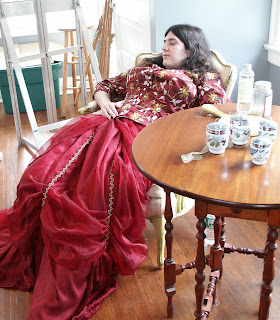 This week’s figure class featured Gail Kellogg Hope modeling a Civil War era gown of her own devising, minus the ruffled hoop. (Readers interested in historic clothing can see Gail’s work here.) Because Gail’s hair was down and she was recumbent, I thought she looked charmingly like a 19th century laudanum addict.
This week’s figure class featured Gail Kellogg Hope modeling a Civil War era gown of her own devising, minus the ruffled hoop. (Readers interested in historic clothing can see Gail’s work here.) Because Gail’s hair was down and she was recumbent, I thought she looked charmingly like a 19th century laudanum addict.
I wanted to begin this essay on languid poses with an American painting, but I was unable to find an American Victorian example. I’m not sure such a painting exists—it would have been contrary to our national myth to see womanhood as anything other than industrious, thrifty, and alert.
 “Baudelaire’s Mistress Reclining,” Edouard Manet, 1862, Szépmüvészeti Museum, Budapest. http://cgfa.dotsrc.org/manet/p-manet35.htm
“Baudelaire’s Mistress Reclining,” Edouard Manet, 1862, Szépmüvészeti Museum, Budapest. http://cgfa.dotsrc.org/manet/p-manet35.htm 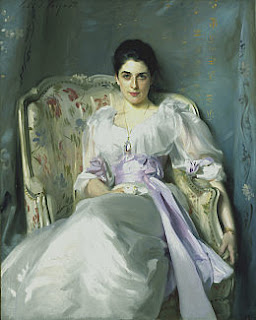
“Lady Agnew of Lochnaw,” 1892-93, oil on canvas, The National Gallery of Scotland http://www.nationalgalleries.org/collection/online_az/4:322/result/0/5396?initial=S&artistId=4829&artistName=John%20Singer%20Sargent&submit=1
The fin de siècle painters were much more comfortable with slouching. I’ve included this example by Sargent largely because the chair resembles the one in my studio—before a century of wear and grime and burst seams. Sargent’s lady reclines, but she is anything but debauched. Instead, the pose is one of aristocratic grace. Although Lady Agnew levels her gaze at the viewer with the same assurance as Jeanne Duval, her chin is down and demure. Notice the right arm culminating in a firm grip—it belies the rest of the pose and points to why Sargent’s portraits are never dull.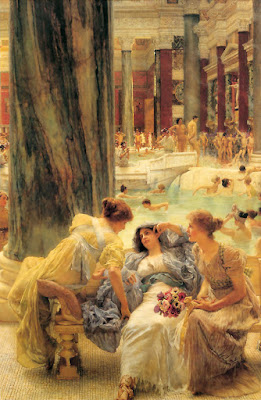
“The Baths of Caracalla,” Sir Lawrence Alma-Tadema, 1899, private collection http://www.artrenewal.org/asp/database/image.asp?id=610
Sir Lawrence Alma-Tadema was proof that not every Dutch painter was brilliant, although he gets my respect for being silly and exuberant. He was, of course, a fine technician. Although not strictly a Pre-Raphaelite painter, he shares with them the tendency to see women as sensual and emotional creatures. In this painting, his Roman matron sinks comfortably into a hard marble bench. Perhaps the background hints that these baths were built by Rome’s most psychotic emperor, but the matron’s couture, coiffure, coloring and companions are strikingly, calmly English. 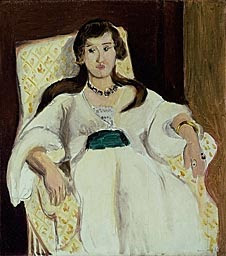
“The Green Sash”, Henri Matisse, 1919, Art Institute of Chicago http://www.artic.edu/aic/collections/citi/object?id=59919&artist=Matisse&keyword=
After that, it is a relief to return to the ambiguity of Matisse. This painting is austere; in fact it has a lot in common with the Manet above. There is no “setting” per se. As in the Manet portrait, the gown has presence and meaning of its own.
Note that in the portrait of Lady Agnew, Sargent is using Matisse’s patterns while in this painting Matisse is using Sargent’s beloved black paint.
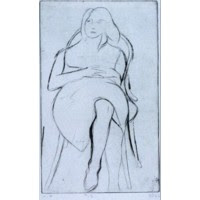
“#13 from the book, 41 Etchings Drypoints,” 1965, Richard Diebenkorn, Fine Arts Museums of San Francisco http://www.thinker.org/imagebase_zoom.asp?rec=6339304212900030
We recognize this last work immediately as a mid-century American drawing by the hemline and the hair. As cloying as that was with Alma-Tadema, it is a virtue in this etching by Richard Diebenkorn. Why is that?
With the hand resting on the abdomen, we have come full circle back to the photo of our model. There seems to be nothing strange about that pose to me, but will future viewers see it as an idiosyncrasy of our age?

Carol,
I am grateful to have you as my very own art appreciation teacher. Thanks for a thought provoking post as well as a visually interesting post.
Observations first. Your comment about the American myth [“it would have been contrary to our national myth to see womanhood as anything other than industrious, thrifty, and alert.] is interesting and I will certainly pay more attention to this in the artwork and photography I view in the coming days. Makes me mindful of an experience I had in Latin America – my guide shared with our group that the girls who were with us stood out as American’s by the way they carried themselves. Understand that both of these young ladies were dark complected with dark straight hair – not at all out of place visually. By the way they walked and stood they were uniquely American.
Observation #2 – I need a primer in artistic iconography. Any suggestions? or do you want to expound on the iconography present in these paintings. [As in the Manet portrait, the gown has presence and meaning of its own.] I’m listening but I’m not hearing anything…
Observation #3. Sargent’s lady is most interesting to me. You mention the clenched right hand as the key to the pose. For me it is the slightly arched eyebrow. Though robed in virginal white with a royal touch of purple (is my iconography on target here?) she is anything but innocent. Notice the darkness near the empty space of the chair. Should I choose to “join” her in her seat I would be in this dark place.
Keep this up please! I look forward to more!
I think I should have used the word “symbolic” instead of “iconographic” in this situation since Manet wasn’t using traditional forms within a recognized genre.
The essay I pointed you to states that Mlle. Duval’s petticoats are emblematic of Baudelaire’s social criticism. (Since Baudelaire was a syphilitic, alcoholic opium addict who liked gothic fantasy, I have no intention of actually reading him, but I can sort of see the sense in the theory.)
What is clear to me is that the petticoat is both a brilliant design device and a barrier between us and the subject. If you bear in mind Mlle. Duval’s roles as actress, dancer, and mistress while you ponder the painting, you begin to see how it is a symbol
I think Manet’s black is absolutely fascinating and revolutionary. (There are some occasions where he got it wrong.) Manet was profoundly influenced by the great 17th century Spanish masters like Zurbaran, Velasquez and Ribera. Both Manet and the Spaniards used lots of black. However, the Spaniards used it as a base for chiaroscuro. Manet divorced it from modeling; it sits on his paintings like an energetic black cloud.
I would caution you against reading too much into Sargent. He was a most straightforward commercial painter, and his work doesn’t allow for subtexts. There is one extant photo of Lady Agnew. She was a great beauty, and her hairline and brow asymmetry are exactly as Sargent painted them. However, there is always something vacuous and idealized in his faces, even though they were presumably accurate-enough to please his clients. (Compare Lady Agnew’s face with Eakin’s wife’s, in the post above.) None of this is to deny his great genius, by the way.
I should caution you that I’m a trained painter, not art historian. So my theories are nothing more than my own crackpot musings.
Now go carve a moai for Paul.
Opium Eater? Mmm. I’ve read about women who were stoned for being adulterous, but it seems like these virginal ladies are stoned and adulterous at the same time and they get away with it. Or is this my typicaly Dutch perspective on these paintings?
typically – with double L of course. Why don’t they allow me to edit a comment? Sigh.
And thanks for the MOAI competition support 🙂 It looks like we have really discouraged other contenders with our skilful master pieces. Yes, I am a modest man. But I still hope that some people will make me laugh with their own potato sculptures! And if not, we will share the price.